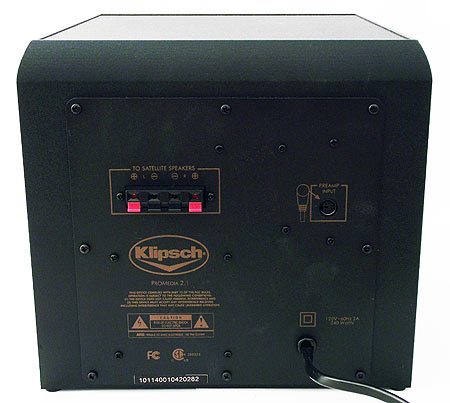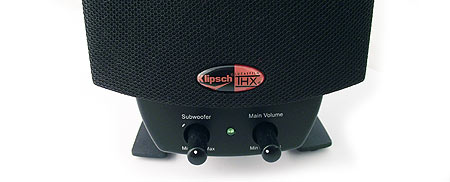Bringing Home The Bass: 2.1-Channel Speaker Roundup
Is it just us, or are 5.1- and 7.1-channel speaker systems impractical for PCs? In our 2.1 speaker roundup, we look at the Corsair SP2500 and Antec/Soundscience Rockus 3D|2.1, along with the Creative Gigaworks 3D, Klipsch Promedia 2.1, and Logitech Z623.
Klipsch Promedia 2.1
Klipsch was one of the first U.S.-based loudspeaker companies, and has been building premium speakers since 1946. The Klipsch Promedia 2.1 has been a staple of upper-echelon 2.1-channel PC speakers systems since its introduction in 2000. While the company recently released a new wireless version, we’re testing the standard, wired speaker set. It can be purchased for $154.99 at bestbuy.com, and comes with a one-year warranty.

The Klipsch Promedia 2.1 is only one of two systems in the roundup that boasts THX certification. A THX-certified audio system meets or exceeds specific levels of audio performance. as specified by THX Ltd. The THX specifications are proprietary and aren’t publicized, but we do know they include things like signal-to-noise ratio and distortion level requirements. Keep in mind that the THX certification isn’t free and, in fact, can be very expensive. This is why many speaker manufacturers do not opt to get the certification, even if their products might meet the standard. There are also four tiers of THX certification, and the “THX-certified multimedia product” is the easiest to achieve.
The subwoofer enclosure is the lightest in the group, containing a single 6.5” long-throw fiber-composite cone subwoofer rated at 130 W peak. At 9.5" x 9.8" x 10.2", the enclosure is only slightly larger than that of the Gigaworks T3.

Despite the relatively low price tag, the Klipsch Promedia 2.1 is only one of two systems in this roundup that offers both a tweeter and driver in each satellite. The tweeter is a 0.75” poly compression driver and it’s paired with a 3” long-throw fiber-composite cone woofer in each satellite measuring 8.5" x 4.2" x 5.67". Individual speaker power isn’t specified, but each channel is rated at 35 W peak per side. The satellites are attractive with or without the removable covers and have an understated home audio look, the only identifying mark being the small orange/gold Klipsch and THX badges.
The Promedia 2.1 speakers don’t include much in the way of separate accessories because they come permanently attached to all of the necessary cables. The 1/8” mini line-in and control interface cables are attached to the right satellite. Both satellites also have speaker cables built in, and these attach to standard speaker clips on the subwoofer.

As an alternative to the line-in cable, users can plug an audio source into the auxiliary input on the right satellite enclosure. A 1/8” headphone jack is also conveniently located here.

The Promedia 2.1 controls are simple, but effective, with volume- and subwoofer-control knobs. A treble control would have been nice, but volume and subwoofer control is par for the course in our roundup.

Get Tom's Hardware's best news and in-depth reviews, straight to your inbox.
Don Woligroski was a former senior hardware editor for Tom's Hardware. He has covered a wide range of PC hardware topics, including CPUs, GPUs, system building, and emerging technologies.
-
clownbaby Wow, those freq response graphs are pretty telling that computer speakers are basically all trash. The bass peaks and generally crappiness in the mid range seem to be a common theme. Almost no consideration seems to be given to music listening.Reply
2.1 is the ideal setup for a computer imo. 4.1 at most. A center channel just isn't needed for monitor sized screens.
You can buy a cheap onkyo receiver, some low end bookshelf speakers and a small sub for a few hundred bucks and have sound that will destroy the best pc speakers.
The fact is, pc speakers are toys. There is no high end option. What they market as high end would be laughed out the door by the regular audio comminuty.
p.s. Plastic is not an acceptable cabinet material -
clownbaby this is what frequency response graphs of decent speakers should look like.Reply
http://www.speakerdesignworks.com/StatementCenterChannelResponsePlots.JPG -
clownbaby this is a frequency response graph of the first diy speaker I built from a popular design. This is a super budget MTM speaker.Reply
http://www.speakerdesignworks.com/TritrixMTMfr.gif -
d0gr0ck clownbabyWow, those freq response graphs are pretty telling that computer speakers are basically all trash. The bass peaks and generally crappiness in the mid range seem to be a common theme. Almost no consideration seems to be given to music listening.2.1 is the ideal setup for a computer imo. 4.1 at most. A center channel just isn't needed for monitor sized screens.You can buy a cheap onkyo receiver, some low end bookshelf speakers and a small sub for a few hundred bucks and have sound that will destroy the best pc speakers. The fact is, pc speakers are toys. There is no high end option. What they market as high end would be laughed out the door by the regular audio comminuty.p.s. Plastic is not an acceptable cabinet materialReply
Pretty much this. I've been telling people for ages that their super-duper PC speakers aren't. Any brand that quotes max power over RMS values raises an instant red flag for me. Even 20yr old Radioshack shelf speakers can run circles on most modern PC speakers.
I die a little bit every time I hear someone with a premium add-in sound card is running generic PC speakers.
-
tigsounds This is all Go out and buy it junk. Build your own and end up with something that rattles the neighbors nerves if done right.Reply -
Mark Heath For all those who trash all PC speakers, they're usually the best option on the lower end of the scale. There are people out there who have compared entry level (sub 400) active speakers to the Klipsch Promedia set (best active speakers ~150 for sound quality imo) and they say that they're not that different. If you do it right, then it's not as bad as you might think.Reply